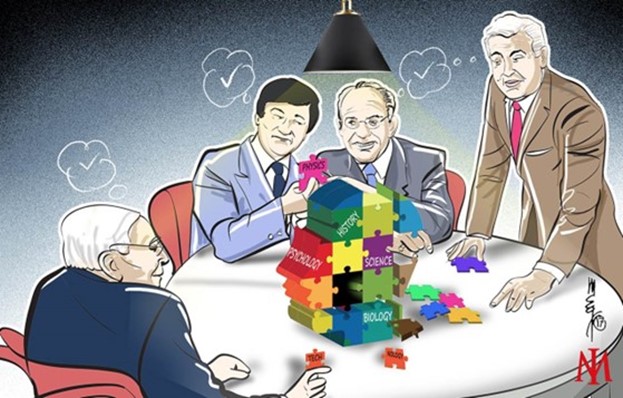
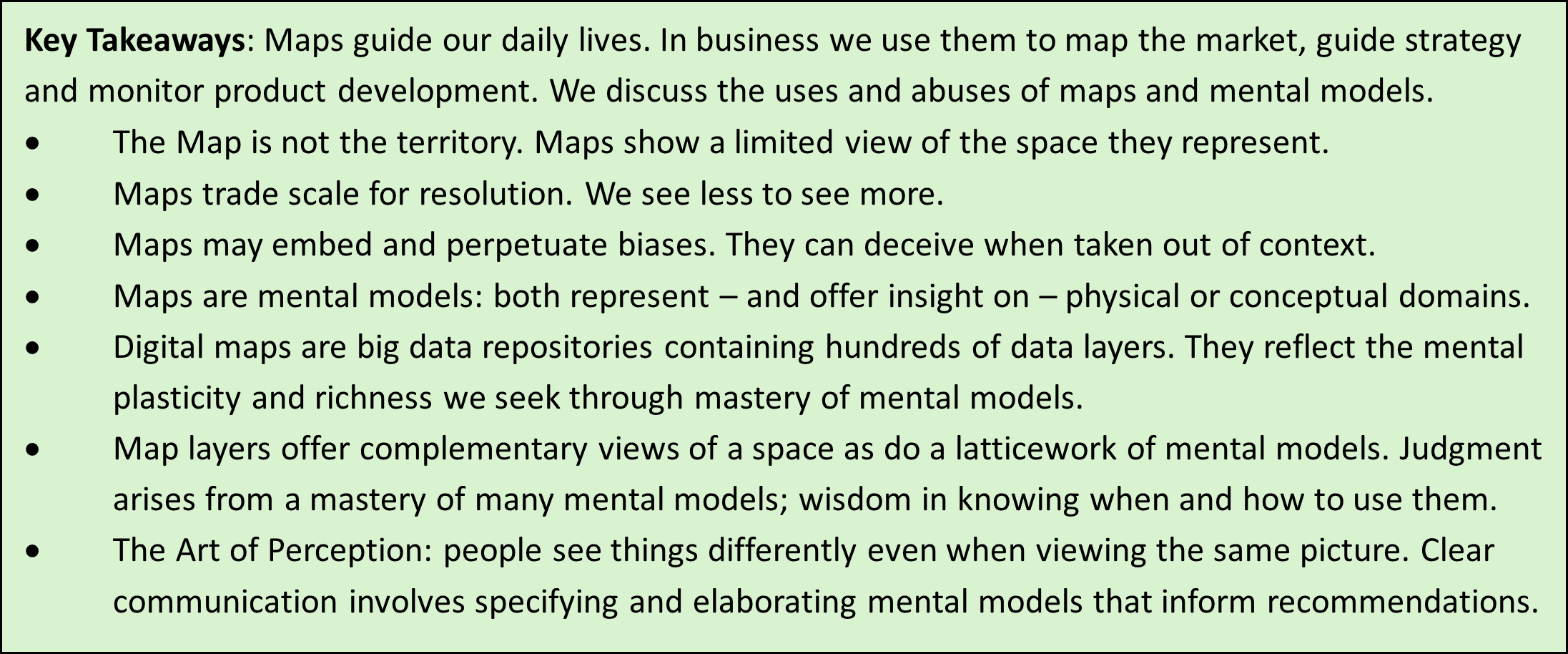
“The Earth’s surface is 70% water. That water is uncarbonated. Therefore, the Earth is … flat.” When Mapping the Territory, beware of maps and mental models used out of context.
In 2020, New York City Transit launched a groundbreaking, digital “Live Subway Map.” The first update of New York City subway maps in over forty years are a big upgrade on previous paper maps shown in Figure 1. With Live Subway Map, users can select the optimal public transit route for any destination in the city and get an estimated arrival time based on real-time availability of trains and buses. Moovit, the #1 global urban mobility app in which we were an early investor, launched a similar service eight years earlier in 2012, which now serves over 1.7 billion users in 3500 cities globally.
Figure 1: New York Subway Maps Past & Present
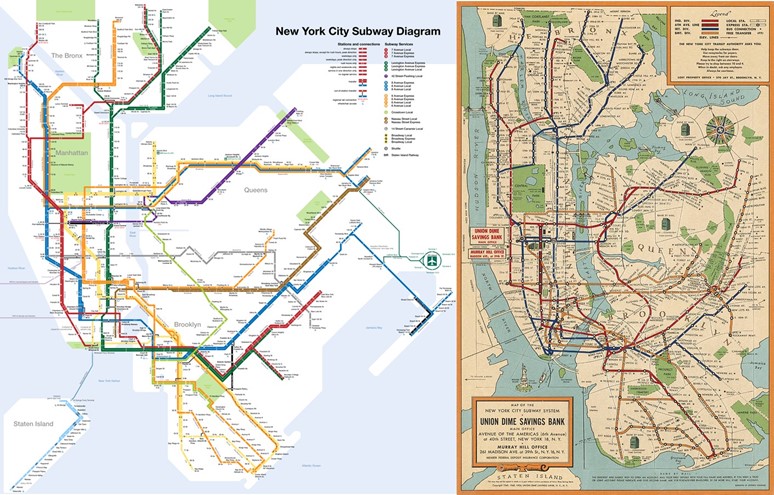
Maps and Mental Models: Pattern Recognition for Entrepreneurs and Investors
Maps guide our daily lives. They help us optimize daily routes and explore new territory. Maps extend well beyond transportation. Political maps convey electoral and legislative sway. Topographical maps inform real estate development, mining and industry. Architectural drawings map buildings for renovation and new construction. Doctors use X-rays to map humans and assess patient health.
Maps are a form of mental models. Maps guide users within a physical space as do mental models within a conceptual domain. The latest version of The Portable MBA includes over fifty graphical frameworks used by executives to manage people, strategy, marketing, operations, finance and technology.
Mental models are essential tools for pattern recognition, which guides venture investors and entrepreneurs as we explore new business opportunities, navigate emerging markets, start new businesses and make investment decisions. As Charlie Munger from Berkshire Hathaway said: “You can’t really know anything if you just remember isolated facts. If the facts don’t hang together on a latticework of theory, you don’t have them in a usable form. You’ve got to have models in your head.” Munger drew broadly from many fields and observed that “80 or 90 models carry 90% of the freight” for investors.
Entrepreneurs and venture investors use a distinct set of frameworks to guide their startups and investment activity. Mental models specific to entrepreneurs include Founder Market Fit, Product Market Fit, Zero to One innovation, Crossing the Chasm, Moore’s Law, the Flywheel, Product Led Growth, Network Effects, Gartner Hype Cycle, Gartner Magic Quadrant and Winner Take Most Markets to name a few.
Munger referred to a ‘latticework of mental models’ that cohere relevant frameworks as depicted in Figure 2. Mastering the meaning of mental models is essential in developing good judgment. Wisdom emerges by assembles complementary frameworks into broader systems of thought and applying them appropriately across a variety of situations.
Figure 2: Seeking Wisdom – Latticework of Mental Models
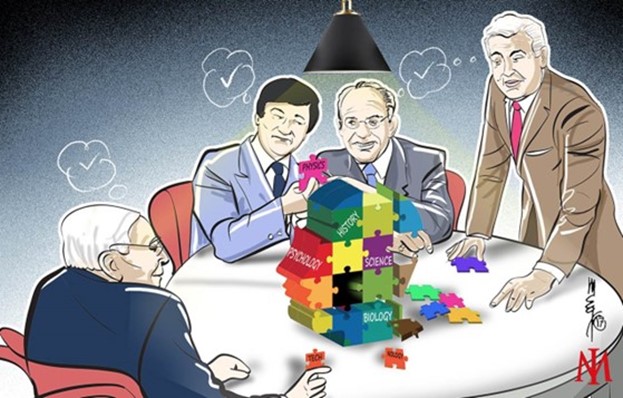
Digital maps are a better analogy than physical maps for a latticework of mental models. Physical maps are static and typically serve a single purpose. Digital maps, now widely available online and in mobile apps, offer more flexibility to focus in or pan out with different data views. Google My Maps, which allow users to customize maps by adding up to ten data layers, is just a foretaste of the flexibility of digital maps with hundreds of data layers offering a myriad of views for different use cases. I hope these musings on mental models will help you develop your toolkit of frameworks with the flexibility and facility of digital map views.
Before studying how these models apply to your business, however, let’s assess the opportunities, challenges and strategies in using mental models.
Maps and mental models apply different levels of abstraction for the territory or principle they represent. As they pan out or focus in, maps trade detail for scale: we observe less to see more. Microscopes and telescopes magnify objects by 50-1000x to see more detail than visible with the naked eye while maps offer less detail as their scope expands. One inch may represent a mile on a hiking map but 15 miles for state maps, 150 miles for the Unites States, 1000 miles for a global map, and millions of miles to map our galaxy. See Figure 3 for an illustration of how our frame of reference and level of detail adjust as map scale expands.
Figure 3: Observe Less to See More – One Inch of Maps at Different Scales
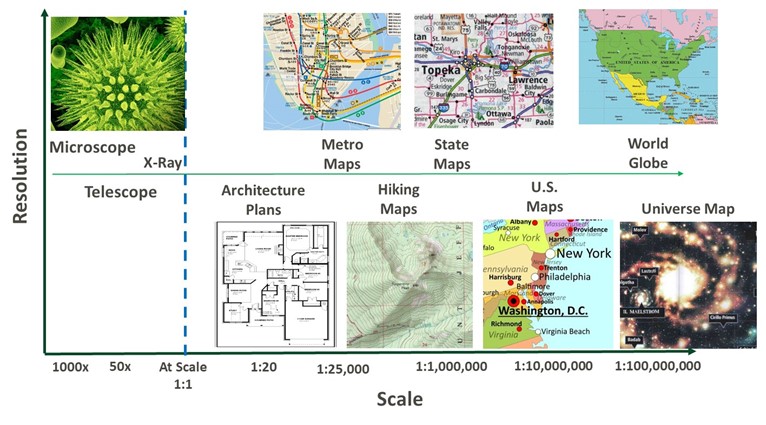
Maps are a caricature of the territory they represent. They look very different if their intended use is for driving, hiking or public transit. Map projections intentionally distort features for their purpose. Converting a globe to a flat 2D flat map requires the mapmaker to shear, tear and compress the territory as Figure 4 illustrates. Greenland is only 7% of the land area of Africa but appears to be just as large in many 2D maps!
Figure 4: Maps Alter the Territory They Represent
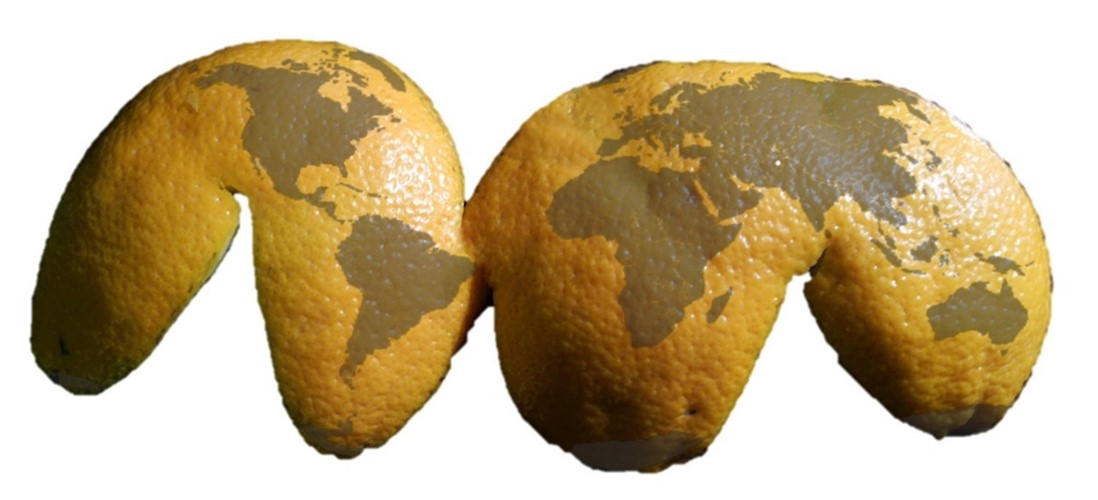
Source: University of Minnesota
Lewis Carroll playfully described the design conundrum for mapmakers in his nineteenth century novel Sylvie and Bruno Concluded: “’What a useful thing a pocket-map is!’ I remarked. ‘That’s another thing we’ve learned from your nation – map-making,’ said Mein Herr. ‘But we’ve carried it much further than you. What do you consider the largest map that would be really useful?’ ‘About six inches to the mile.’ ‘Only six inches!’ exclaimed Mein Herr. ‘… We actually made a map of the country, on the scale of a mile to the mile!’ ‘Have you used it much?’ I enquired. ‘It has never been spread out yet,’ said Mein Herr: ‘the farmers objected: they said it would cover the whole country and shut out the sunlight! So we now use the country itself as its own map, and I assure you it does nearly as well.’
Mapping the Territory: Using Mental Models in Our Daily Lives
We use mental models in our daily lives whether consciously or unconsciously. In Thinking, Fast and Slow, Nobel Laureate Daniel Kahneman described two modes of thought: “System 1” is fast, instinctive and emotional while “System 2” is slower, more deliberative, and more logical.
Mental models assist us with both modes of thought. We make thousands of System 1 decisions daily, often unconsciously. System 1 decisions are instinctual relying on mental shortcuts and heuristics even for fight or flight decisions necessary for survival. Mental models aid System 1 decisions by helping us make sense of the world rapidly and efficiently.
Mental models are equally important in System 2 thinking – those occasional, important decisions that potentially alter the course of our company, career or lives. These are Board level decisions for startups and partner level judgments for venture firms. Good judgment requires that we apply the Prudent Man Principle approaching these decisions thoughtfully, logically and dispassionately. Mental models help ensure we approach these decisions with the attentiveness and rigor they deserve.
Mapping the Territory: The Uses and Abuses of Mental Models
Yet as Kahneman forewarned, both modes of thought are vulnerable to predictable irrationality. Kahneman identifies a dozen cognitive biases that color our decisions and lead to consistent errors in judgment. When used well, mental models provide perspective but reinforce biases if they are reflected in the model. In such cases, mental models reinforce our preconceptions, facilitate narrative bias, and perpetuate ‘Noble lies.’
Like maps, mental models are useful if we are cognizant of and account for their limitations:
- Simplifications: Models are potentially powerful as they distill complexity by focusing on key elements and discarding less crucial details. Yet we must be cognizant of the loss of fidelity as, often, the devil is in the details.
- Representations: The Map is Not the Territory, and mental models represent but do not reproduce reality. Models offer perspective by illuminating general principles. Yet we risk fooling ourselves if we ignore substantive details that the model overlooks. Models are most useful when they help clarify thought and elicit different perspectives.
- Change: Maps may quickly become outdated. Models should stand the test of time as history does not repeat itself but it rhymes, though we should frequently revisit our models in rapidly changing markets.
Figure 5: Stock Market Maps

Mapping the Territory – Strategies for Navigating and Exploring New Markets:
Maps and mental models have many limitations as we have noted, yet we rely on them daily consciously and unconsciously. For deliberative decisions, the limitations of mental models do not preclude their use. Instead, good judgment requires that we use mental models selectively, conscientiously and explicitly. Following are six strategies that reinforce prudent decisions and mitigate biases that emerge as entrepreneurs and investors commit time and effort to an endeavor.
- Live Maps – Mental Plasticity: Digital maps provide three advantages over physical maps. As illustrated in New York City with the Live Subway Maps in Figure 1, they: (1) are live maps that adjust in real-time with updated information; (2) function well at different map scales and levels of granularity; and (3) synthesize many layers of data adjusting as needed for different use cases. Similarly, entrepreneurs and investors must adapt seamlessly in rapidly changing, uncertain environments. In Mindset: The New Psychology of Success, Carol Dweck asserts a Growth, not Fixed, Mindset enables adaptability and perseverance. We must maintain mental plasticity, which measures the brain’s ability to reorganize and grow through learning and experience. Nurturing curiosity for lifelong learning, open mindedness, humility and an adventurous spirit helps retain a Growth Mindset required for success.
- Map Coordinates – Navigation: In math the shortest distance between two points is a straight line. Straight routes are rarely available on maps. Often, as with windy roads through mountains, crooked paths are most efficient. Sailors tack and jib to navigate against headwinds. Hikers follow switchbacks to reach mountain summits. Skiers follow a fall line through mogul fields. Navigation is especially challenging in the ‘fog of war’ or on mountains shrouded in clouds. When driving in a city, we rarely park at our meeting spot; instead, we navigate toward our destination and then search for nearby parking. Similarly, strategies that align with a company’s mission provide a clear sense of direction when navigating rapidly changing markets. Rather than fixating on one destination, the most efficient path may be to navigate toward a quadrant consistent with the vision shortening distance to the destination with each step while sidestepping local obstacles.
- Toolkit Checklist: No pilot takes off without reviewing a checklist. Airline accidents per million flights declined by 95% in the 1960s after checklists were adopted. Both Kahneman and Munger recommend a mental model checklist to assess situations from different angles before making a decision. Multiple, complementary mental models reinforce balanced assessments when applied appropriately. Alfred Lin, a Partner at Sequoia Capital, discusses the ability to hold two opposing ideas to find the right altitude in any decision. Figure 6 illustrates six frameworks that map markets from different altitudes offering varying perspectives on market opportunity. At NGP Capital, we consider a checklist of 30 or so frameworks when evaluating potential investments.
Figure 6: Selected Market Maps – Tradeoff Between Scale and Resolution
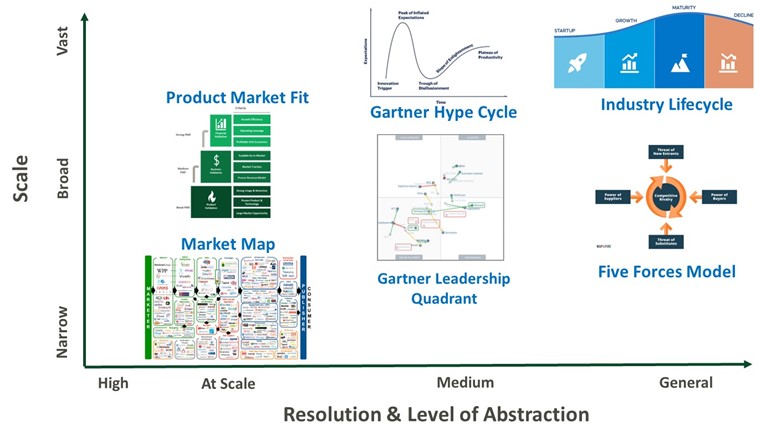
- Navigating Change – Superforecasting: Maps quickly become outdated, but most models should stand the test of time. As a young venture investor three decades ago, I kept physical files on emerging software market segments but found I had to redo my filing system annually as market segments were constantly splitting, merging or emerging. Updating my filing system offered insight into emerging market opportunities. Similarly, in Superforecasting: The Art and Science of Prediction, Tetlock highlighted how the best forecasters constantly update their models to account for new information and changing circumstances. The best frameworks help us navigate through change and uncertainty while enabling us to revisit our forecasts frequently and remain attuned to current conditions.
- Project Teams – Inverter: Munger advised “invert, always invert.” He also said, “Tell me where I may die so I don’t go there,” which worked well as he lived nearly a century. Inverters offer perspective, boost creativity and mitigate biases. Boards serve a similar purpose, but they engage at the end with little ability to counteract biases already embedded in the process. In Superforecasting, Tetlock observed that project teams, especially complementary teams of experts with diverse perspectives, outperformed individual experts in their global forecasting contests. As NGP Capital, we do our best in project teams with an “inverter,” who keeps the checklist and serves as the resident skeptic. Increasingly, artificial intelligence augments human intelligence offering options never previously considered by humans.
- Communication: In the Art of Perception, Amy Herman observes that we often see different things even when looking at the same picture. Views will vary further when we rely on mental models implicitly. We can communicate more clearly by being explicit about our mental models and explaining how they apply to the situation.
Entrepreneurs and investors deal with ambiguity daily while navigating rapidly changing, uncertain markets. Mental models should not add to the uncertainty and ambiguity. This article reminds us that every framework involves compromises. Yet, when used well, mental models offer perspective and signposts to help navigate through the fog of nascent markets.
The Map is Not the Territory: Related Concepts
Maps and mental models share common characteristics as they represent physical or conceptual domains. They provide Frames of Reference that may reinforce cognitive biases. Behavioral Economics highlights the role of unconscious heuristics that lead to bounded rationality.
Applying the Prudent Man Principle requires particular care in a predictably irrational world. This article outlines several safeguards when applying mental models, including the use of checklists, inverters and clear communication while avoiding groupthink. A latticework of mental models reinforces systems thinking and helps avoid selection bias by highlighting frameworks favorable to one’s predilections. First Principle thinking, like maps and mental models, reduces a problem to its essential components using a deductive approach. Experience permits pattern recognition, but beware of overfitting frameworks and ignoring unique characteristics of each situation.
